#cavitation meter
Text

The MCT-2000 acoustic cavitation meter is a cutting-edge device designed to measure cavitation performance in ultrasonic cleaning and sonoprocessing tasks. When paired with the HCT-0320 hydrophone, it instantly calculates four primary parameters:
Base Frequency, FO
Initial Field Pressure, PO
Consistent Cavitation Pressure, PS
Short-lived Cavitation Pressure, PT
These measurements are derived from the calibrated acoustic spectrum, which identifies various pressure elements. Transducers produce mechanical sound waves that vibrate at the base frequency, leading to the initial field pressure. Swift pressure variations in the fluid form cavities, termed "cavitation". Consistent cavitation indicates a fluctuating cavity, causing micro-streaming effects. Short-lived cavitation emerges past a certain pressure level, causing the cavities to burst, leading to jetting actions and shockwaves.
1 note
·
View note
Text
Wet Beast Wednesday: pistol shrimp
Oh snap, it's the snapping shrimp post for Wet Beast Wednesday! Snapping shrimp or pistol shrimp are loud little critters that have evolves a very useful and fascinating tool in their pincers. Let's not waste time and shoot off to learn about these little gunslingers.
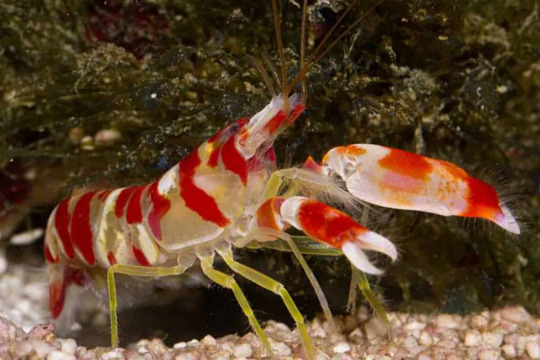
(Image: a pistol shrimp. It is a mostly white shrimp with red stripes. One of its claws is considerably larger than the other. It is standing on gravel and next to some seaweed. End ID)
Pistol shrimp are over 1,000 members of the family Alpheidae, which is part of the infraorder Caridea. This means they are true shrimp, not to be confused with superficially similar animals like brine shrimp, mantis shrimp, tadpole shrimp, and prawns. Yeah, I only recently learned that prawns and shrimp aren't a language difference between British English and American English like chips vs fries. They're not even that closely related. As true shrimp, pistol shrimp have two main body parts: the cephalothorax and abdomen, which are composed of 19 body segments. The abdomen forms a flexible tail with a fin on the end. When startled, the fin can rapidly curl under the body, propelling the shrimp backwards. Like other decapods, there are 10 limbs. The front pair of limbs have evolved into claws used to manipulate objects. The claws are the most distinguishing feature of pistol shrimp. They are asymmetrical, with one growing extremely large, over half the size of the body. The big claw has a modified version of the typical pincer. This pincer has an upper claw that can open up at a right angle. Under the claw is a pocket in the lower pincer, into which water flows. The upper pincer then slams down into this pocket, forcing the water out. The pressure of the pincer closing water in the pocket creates a cavitation bubble that is forced away from the claw at up to 26.8 meters per second. This is enough force to seriously wound small animals and hurt larger ones into leaving the shrimp alone. The cavitation bubbles can reach up to 4,427 degrees C (8,000 F) . For comparison, the surface of the sun is about 1,000 decrees (C) hotter. When the bubble pops, it creates a snapping sound that can reach 218 decibels. For comparison, most gunshots max out at around 170 db. This puts pistol shrimp is the running for the loudest ocean animals, with whales being the other main competitors. If that all sounds like a lot, the whole event happens so fast that the heat doesn't have time to affect much and the noise sounds like a moderately loud snap to us. Adults can snap their claws shut with an acceleration of up to 30 meters per second squared and juveniles can do it up to 20 times faster. The whole process takes less than a millisecond. When the cavitation bubble collapses, it can produce light. This is called sonoluminescence and nobody knows how it happens. If a pistol shrimp loses its large claw, the small claw will grow into a new large one while the missing limb will regenerate into a small claw. Adult pistol shrimp average between 3 and 5 cm long.
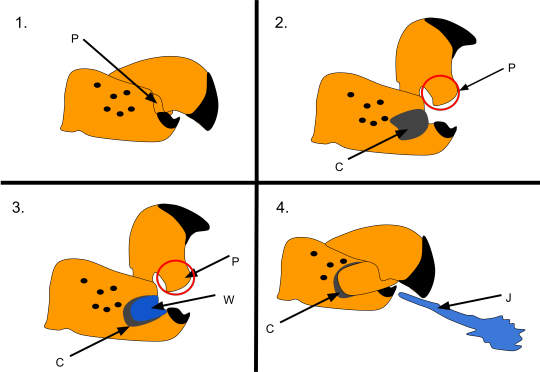
(Image: a drawing showing the process of a pistol shrimp snapping its claw. In the first panel, the claw is closed. In the second, the upper claw opens at a 90 degree angle, revealing a cavity. In the third panel, the cavity fills with water. In the final panel, the claw is closed again and a jet of water is ejected from the claw. End ID. Source: Wikipedia user Carermyers)
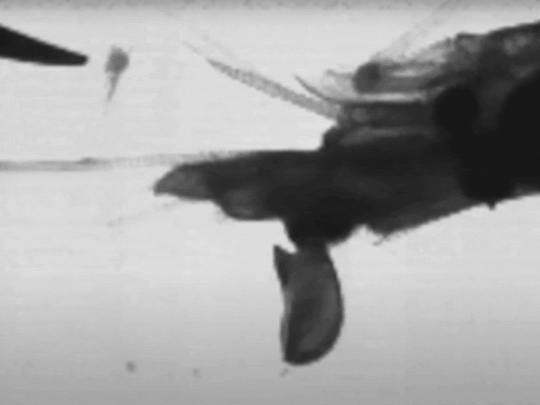
(Gif: black and white, slow-motion video of a pistol shrimp's claw snapping shut and creating a cavitation bubble. End ID. Source)
Pistol shrimp live worldwide, though most species live in tropical or temperate water. There are some cold water species and even freshwater species. Most prefer habitats where they can make burrows and where there are plenty of other animals. Coral reefs, oyster reefs, seagrass beds, mangrove groves are common habitats. Snapping is used for hunting and communication. They typically hide in burrows, waiting for fish or other small animals to pass by. When prey passes, the shrimp will snap to stun or seriously wound the prey, then drag it into the burrow. Some social species actually form eusocial hives with a single queen who produces all offspring. These shrimp are the only known marine eusocial species and all occur within the same genus (Synalpheus), though not every member of that genus is eusocial and eusociality appears to have evolved at least 3 times within that genus. It appears that a reason why only this genus developed eusociality is their larvae do not disperse, instead staying in the same area as the parents. The hives are usually located within sponges. Other social species are not eusocial, but still live together in colonies. Many less social species have formed a symbiotic relationship with gobies. Both species live in burrows, but gobies are bad at digging while the shrimp have poor eyesight. The goby will protect the shrimp while it digs a burrow, then the two live together. They will forage together, with the goby using its superior eyesight to watch for predators and warn the shrimp to get back to the burrow. Pistol shrimp are monogamous, the same pair coming back to mate over and over again (this does not apply to the eusocial species in which only the colony's queen is permitted to mate). The female is only fertile during a short period after molting. The male will stay with the female and protect her during the vulnerable period after mating and some species will remain with each other until the eggs hatch or permanently.
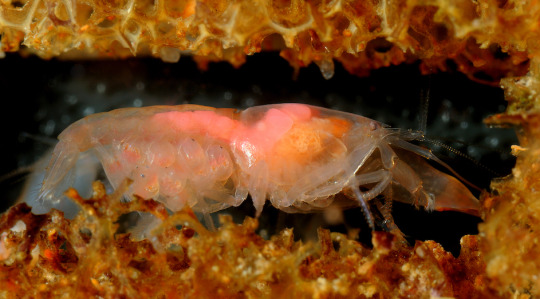
(Image: a eusocial pistol shrimp queen with eggs. Her body is translucent and multiple eggs are attached to her abdomen. The eggs look like translucent balls. The is inside of an orange sponge. End ID)
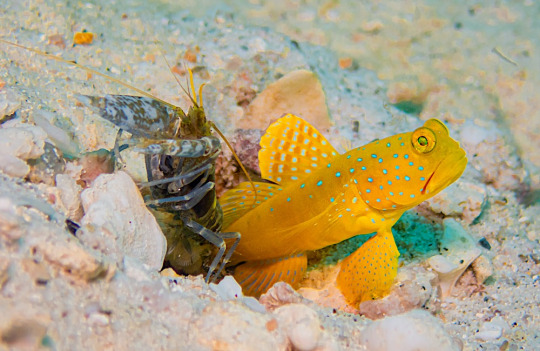
(Image: a pistol shrimp and goby emerging from a burrow in the sand. The shrimp is a mottled green and white. The body is a bright yellow fish covered with blue spots. End ID)
Pistol shrimp are a major source of noise in the places where they live. If you've ever been swimming and can hear repeated cracking noises, that may have been a bunch of pistol shrimp. Some scientists monitor the level of pistol shrimp noises as a method of monitoring the ecosystem. If the noise level drops, that is an indicator that the local ecosystem is suffering. The noise of the shrimps can get so loud that it actually interferes with sonar and forms of underwater communication. During World War II, members of the navy realized that the shrimp disrupted sonar enough to hide submarines, so they started hiding submarines near reefs with lots of the shrimp to keep them from being found by enemy subs. Weirdly not the only small marine animals to mess with submarines. I'll get the the other major one soon. The largest threats to pistol shrimp come from habitat destruction. Some species of pistol shrimp have entered the pet trade. As coral reefs, seagrass beds, and other habitats are destroyed, the shrimp that rely on them will suffer as well.

Yet another time I get to use one of these cards in a post
(Image: the Weird n' Wild Creatures card featuring pistol shrimp. End ID)
#wet beast wednesday#pistol shrimp#snapping shrimp#shrimp#decapod#crustaceans#marine biology#biology#zoology#ecology#animal facts#eusocial#symbiosis#goby#informative#image described
241 notes
·
View notes
Text
Another fuel tanker, identified as the “MTKR Jason Bradley,” sank in shallow waters off Mariveles, Bataan, on Saturday afternoon as salvage operations on the sunken Terra Nova, which is still carrying its cargo of 1.4 million liters of industrial fuel, was postponed, the Philippine Coast Guard (PCG) said on Sunday.
According to the PCG, Jason Bradley was reported to have no cargo on board, but PCG divers found fuel leaks on the vessel and an undetermined amount of diesel.
The oil tanker sank Saturday afternoon in waters nine meters deep off Barangay Cabcaben, just half a kilometer from the shore and just two days after the sinking of the Terranova on July 25.
As of July 27, the map indicates that the oil spill may cover an area of approximately 68.01 square kilometers, a significant increase from [Philippine Space Agency or] PhilSA’s July 26 estimate of 14.4 square kilometers.
“We haven’t fully recovered from the severe impact of Supertyphoon Carina and the current southwest monsoon,” said Richard Catenza, leader of a fishers group in Cavite.
“Fishing has been disrupted for over two months due to large waves and strong winds. We cannot endure another looming tragedy caused by this oil spill,” noting that the incident may also affect fish prices in the Manila Bay area.
Ronnel Arambulo, vice chairperson of the activist Pambansang Lakas ng Kilusang Mamamalakaya ng Pilipinas (Pamalakaya), criticized the government for the pace of its actions in both the Princess Empress [in 2023] and Terranova oil spills.
The organization said it is monitoring several coastal towns in Cavite that could be affected, including Tanza and Rosario, where more than 10,000 fisherfolk may be impacted.
2024 Jul. 29
3 notes
·
View notes
Text

Maragondon, Cavite and Nasugbu, Batangas
Major jump-off: DENR Station, Magnetic Hill, Ternate, Cavite
Minor jump-off: Sitio Fronda, Brgy. Papaya, Ternate-Nasugbu Highway, Nasugbu, Batangas
LLA: 14° 12.855 N; 120° 38.785 E; 664 MASL
Days required / Hours to summit: 1-2 days / 2-5 hours
Specs: Minor climb, Difficulty 3/9, Trail class 1-3
Features: Distinctive spire at the summit, forests, scenic views of Cavite
Mt. Pico de Loro is located in Cavite province, it grants climbers and visitors a breathtaking perspective of Cavite and the state of Batangas as well as the South China Sea. The elevation of Mt. Pico de Loro is 688 meters, or 2257 feet. It is Cavite's highest point. In the province of Batangas, the municipality of Maragondon contains the mountain's northern half, and the municipality of Nasugbu has its southern half. The monolith of Mount Pico de Loro is a 50-foot-tall solitary stone pillar that is located not far from the top. While climbing this monolith involves some bouldering and rappelling, once hikers reach the top of the rock peak, they can be proud of themselves. A spectacular and lifelong memory-making view awaits hikers as their reward.
Pico de Loro refers to "Parrot's Peak." It was rumored that the mountain received its name from its pointed peak, which from a distance resembles the shape of a parrot's peak and is regularly used by seafarers as a marker to turn in the direction of the east in order to reach the historic Manila Bay and Corregidor Island.


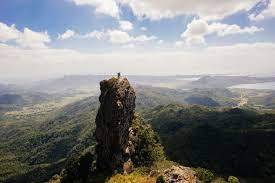

9 notes
·
View notes
Text
And now, an entirely bizarre edition of Spooky Tales from the Transmitter Site:
The older of my two sites lies on a weird triangle of land bordered by a levee and a former railroad grade. On the levee side is a slough that's part of the Sacramento River Delta. At some point in its history, someone added a pump to help keep it from flooding.
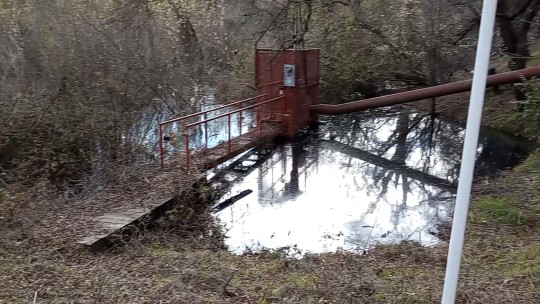
No one knows who added it. No one knows when it was added. No one knows who pays the power bill for that meter.
It's simply
just
there.

One of the other engineers suggested to me that at some point in history, a former engineer used to do something to run and maintain it.
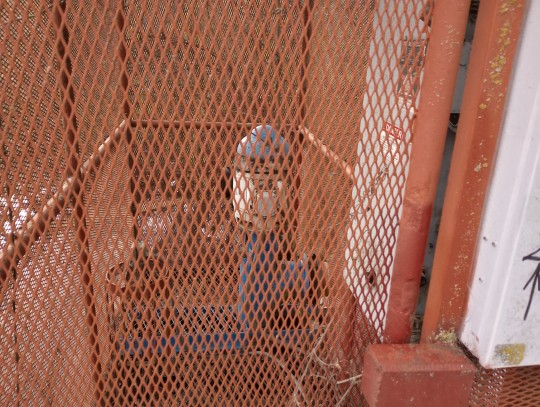
About three years ago one of my coworkers saw a crew doing repair work on it. He didn't know who they were.

They just.... were. Just as it just.... is.

But it's both forgotten and not forgotten. This tag suggests that someone fixed up the power to it but left it turned off pending verification that they wired it right. See, this has a three phase motor on the pump. If you mix up the wires to one, it will run, but backwards.

I think the pump (obscured completely by the pitch black water, sorry!) is a vertical impeller type. My suspicion is that if you were to run it backwards, you'd get next to no water flow and a lot of cavitation noise.

Out of curiosity (and desire to prevent the weird old thing from just being consumed forever by the stinky slowly rising water), I took a gamble and turned on its switch... and it very quietly and dutifully began yeeting water out on the other side of the levee.
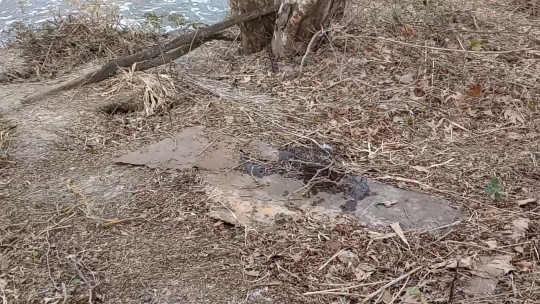
And out of this rusty object too, I suppose.
I may never know the mysteries of this thing, but at least it looks like it'll help avoid flood damage.
20 notes
·
View notes
Text
Sizing the Pump Correctly: Why It Matters and How to Get It Right
Selecting the right pump for your system is crucial for ensuring optimal performance, efficiency, and longevity. An incorrectly sized pump can lead to a host of issues, from increased energy costs to premature wear and tear. In this blog, we’ll explore why proper pump sizing is so important, the key factors to consider, and how to ensure you choose the right pump for your specific application.

1. Why Proper Pump Sizing is Essential
Energy Efficiency: A correctly sized pump operates within its optimal efficiency range, reducing energy consumption and lowering operating costs. Oversized pumps, on the other hand, often run at reduced capacity, leading to energy waste and higher utility bills.
System Performance: The pump’s size directly affects the system’s overall performance. An undersized pump may not provide the necessary flow or pressure, while an oversized pump can cause issues like cavitation, vibration, and noise.
Longevity and Reliability: Pumps that are too large or too small for the application are more likely to experience mechanical stress, leading to increased wear and tear and a shorter lifespan. Properly sizing the pump helps ensure reliable, long-term operation.
Cost Savings: Investing in the right-sized pump reduces the likelihood of frequent repairs and replacements, ultimately saving you money on maintenance and extending the life of your equipment.
2. Key Factors to Consider When Sizing a Pump
Flow Rate (Q): The flow rate, measured in gallons per minute (GPM) or liters per second (L/s), is the volume of fluid the pump must move within a given time. It’s essential to accurately determine the required flow rate for your application to ensure the pump can meet the system’s demands.
Total Dynamic Head (TDH): TDH is the total equivalent height that a fluid is pumped, accounting for the elevation change, pressure requirements, and friction losses in the system. It’s measured in feet or meters and is a critical factor in determining the pump’s required power.
Fluid Characteristics: The type of fluid being pumped (e.g., water, chemicals, slurry) affects the pump’s material selection and design. Consider the fluid’s viscosity, temperature, and corrosiveness when sizing the pump.
System Design and Configuration: The layout of your piping system, including pipe length, diameter, and the number of bends and fittings, impacts the friction losses that the pump must overcome. Accurate system design data is essential for proper pump sizing.
Pump Efficiency Curves: Review the pump’s performance or efficiency curves, which show the relationship between flow rate, head, and efficiency. Selecting a pump that operates near its Best Efficiency Point (BEP) ensures optimal performance and energy savings.
3. Steps to Correctly Size a Pump
1. Define System Requirements: Start by gathering all relevant data, including required flow rate, TDH, fluid properties, and any specific pressure requirements. This information forms the basis for selecting the appropriate pump.
2. Calculate Total Dynamic Head (TDH): Use the following formula to calculate TDH:
TDH = Static Head + Pressure Head + Friction Losses
Static Head: The vertical height difference between the pump’s suction and discharge points.
Pressure Head: The pressure required at the discharge point, converted into equivalent head.
Friction Losses: The energy loss due to friction as the fluid moves through pipes, valves, and fittings.
3. Select a Pump Based on Efficiency Curves: Review pump efficiency curves from different models that meet your flow rate and TDH requirements. Choose a pump that operates close to its BEP for maximum efficiency and reliability.
4. Consider System Variability: Account for potential variations in system demand, such as changes in fluid levels, temperature fluctuations, or varying flow rates. Choose a pump that can handle these variations without compromising performance.
5. Perform a Final Check: Ensure the selected pump meets all system requirements and review the manufacturer’s specifications to confirm it’s the right fit. Consult with a pump specialist if needed to validate your choice.
4. Common Mistakes to Avoid in Pump Sizing
Oversizing the Pump: Many people mistakenly believe that a larger pump will perform better, but oversizing can lead to inefficiency, increased wear, and higher operating costs.
Ignoring Friction Losses: Underestimating or ignoring friction losses in the system can result in choosing a pump that cannot deliver the required flow or pressure.
Failing to Consider Future Needs: Neglecting to account for potential future system expansions or changes can lead to a pump that’s inadequate or inefficient down the line.
Not Consulting with Experts: Pump sizing is complex, and making a mistake can be costly. It’s wise to consult with experts or use specialized software to ensure accurate sizing.
5. Tools and Resources for Pump Sizing
Pump Selection Software: Many manufacturers offer pump selection software that simplifies the sizing process by allowing you to input system data and automatically generate suitable pump options.
Consultation with Pump Specialists: Working with experienced pump specialists can help you navigate the complexities of pump sizing and ensure you select the right pump for your application.
Educational Resources: Utilize online guides, webinars, and industry publications to deepen your understanding of pump sizing and stay informed about best practices.
Proper pump sizing is essential for ensuring the efficiency, performance, and longevity of your system. By taking the time to accurately determine your system’s requirements and selecting a pump that meets those needs, you can avoid common pitfalls, reduce energy costs, and maximize the reliability of your equipment. Whether you’re designing a new system or upgrading an existing one, getting the sizing right from the start is a critical step in achieving long-term success. For more info contact Lowara Pump Supplier in UAE or call us at +971 4 2522966.
#lowara pumps uae#lowara pump dealer in dubai#lowara pump distributors#lowara pump suppliers#lowara pumps#lowara pump supplier#lowara pump supplier in uae
0 notes
Text
Trabyahe: Entry No. 9
Experience Breathtaking Views at Mt. Pico de Loro

Image credit: lakbaydiwapinas.com
Welcome to Mt. Pico de Loro!
Are you looking for an adventure that combines beautiful scenery and a bit of challenge? If so, Mt. Pico de Loro is the perfect destination for you! Located in the Mt. Palay-Palay range, this stunning mountain sits on the border between Ternate, Cavite, and Nasugbu, Batangas. It’s a popular spot for hikers of all skill levels, from beginners to experienced climbers.

Image credit: Camille Ann FB Post
Why Choose Mt. Pico de Loro?
With an elevation of 664 meters above sea level, Mt. Pico de Loro is the highest mountain in Cavite. What makes it special is its height, lush green forests, and interesting rock formations. The climb has a difficulty rating of 3 out of 9, which means it is considered an easy climb for most people. You can usually reach the campsite at the base in about 3 to 4 hours, depending on how fast you hike.

Image credit: Camille Ann FB Post
The Adventure Begins
As you journey, you’ll walk through beautiful trails surrounded by tall trees and vibrant plants. The fresh air and sounds of nature make the hike enjoyable. Take your time to appreciate the surroundings, and don’t forget to capture some photos along the way. This is a great opportunity to bond with friends or meet new people who share your love for adventure.

Image credit: Camille Ann FB Post
Amazing Views Await
When you finally reach the top of Mt. Pico de Loro, you’ll be greeted by breathtaking views. The summit offers a 360-degree panorama that includes stunning sights like Manila Bay and Corregidor Island. You can also see the distant mountains of Nasugbu and the beautiful Limbones Cove. The vast expanse of the West Philippine Sea stretches out before you, making it a perfect spot to sit back, relax, and take it all in. It’s truly a moment you won’t forget.

Image credit: traveltripjourney.com
Helpful Tips for Hikers
Bring Water: Staying hydrated is essential, especially during the hike. Make sure to carry enough water with you.
Wear Comfortable Clothes: Dress in light, breathable clothing, and wear sturdy hiking shoes to keep your feet protected.
Respect Nature: Remember to leave no trace. This means cleaning up after yourself and respecting the environment so that others can enjoy it too.

Image credit: nojuanisanisland.com
Conclusion
Mt. Pico de Loro is more than just a hike; it’s an experience filled with adventure, beauty, and a sense of accomplishment. Whether you are climbing for the first time or have hiked many mountains, this destination offers something for everyone. So grab your gear, gather your friends, and get ready for an unforgettable journey to the top of this magnificent mountain. Pico de Loro awaits, ready to show you the wonders of nature!
References:
Enriquez, K. (2018, June 20). PICO DE LORO – Traverse and Monolith: dangerously beautiful. treacherous yet irresistible. A Wanderful Sole. https://www.awanderfulsole.com/pico-de-loro-traverse-and-monolith-dangerously-beautiful-treacherous-yet-irrisistable/
H, J. (2024, February 4). 18 best Cavite tourist spots & things to do: historical sites, beaches & waterfalls. Cultural Creatives. https://culturalcreatives.org/things-to-do/tourist-spot-in-cavite/?fbclid=IwZXh0bgNhZW0CMTEAAR3koaIyBWzWmcfAZt1b3PKIAiODU_CNYZjemcpt2HbRsLBZrW1jVhMCV3E_aem_rDS53pcnf5IrJ2Wfrli9SA
https://www.facebook.com/share/p/uJjFDr6MH29fRBhX/?mibextid=xfxF2i
1 note
·
View note
Text
Article 1416 Obligations and Contracts
Article 1416. When the agreement is not illegal per se but is merely prohibited, and the prohibition by the law is designed for the protection of the plaintiff, he may, if public policy is thereby enhanced, recover what he has paid or delivered.
Related Case :
[ G.R. No. 192629, November 25, 2015 ]
FILINVEST LAND, INC., PETITIONER,
VS. EDUARDO R. ADIA, etal . RESPONDENTS .
FACTUAL BACKGROUND
The respondents were the registered owners of various parcels of land located in Barangay Hugo Perez, Trece Martires, Cavite. These properties were awarded to them pursuant to the Comprehensive Land Reform Law (CARL). and had a total land area of about 709,910 square meters under seventy-five (75) TCTs.
In 1995, Filinvest Land, Inc. (Filinvest) acquired possession of these properties. Each of the respondents executed a Sinumpaang Salaysay entitled Pagbibitaw ng Karapatan (affidavits). Based on these affidavits, the respondents relinquished all their rights over the properties for valuable consideration.
The respondents alleged that they surrendered possession of their properties with the understanding that Filinvest would develop these into a residential subdivision, pursuant to a joint venture agreement (JVA). They also entrusted their respective owner's duplicate original copies of the TCTs to Filinvest because they were told that these would be used in preparing the development plans. The respondents added that they were even given money to find their own place while the development was taking place.
The respondents repeatedly requested Filinvest to return their owner's TCT copies and to give them a copy of the JVA. Since development had not yet begun, they also sent a letter to Filinvest to allow them to temporarily return to their lands. They received no response. Instead, Filinvest began to fence the area and prohibited entry. To protect their rights, the respondents filed notices of adverse claim.1aшphi1
In 2010, the respondents filed a complaint for recovery of possession with damages against Filinvest.
Issue :
The Core issue in an accion publiciana is who between Filinvest and the respondents are the properties lawful possessors.
Held :
In the present case, the parties do not dispute that the transfers occurred within the ten-year period. Filinvest contends, however, that only transfer of ownership is prohibited, not of possession.
Filinvest claims that if the affidavits are void, this Court should consider the parties to be in pari delicto. Both parties came to court with unclean hands because they voluntarily entered into the void transactions. Thus, the court should leave them where they are Filinvest possessing the properties and the respondents keeping the money they received.
We see no merit in Filinvest's position.
To elaborate, Article 1416 of the Civil Code provides an exception to the pari delicto doctrine. Under this article, the plaintiff may recover what he paid or delivered pursuant to a void contract if the following requisites are met: (a) the contract is not illegal per se but merely prohibited; (b) the prohibition is for the plaintiffs protection; and (c) public policy will be enhanced by his recovery. These requisites are present in this case.
In sum, we hold that the respondents are the lawful possessors of the disputed properties. Their affidavits are void and did not transfer possessory rights.
of real estate or any interest therein affecting registered land judgment is entered for the plaintiff, such judgment shall be entitled to registration on presentation of a certificate of the entry thereof from the clerk of court where the action is pending to the Register of Deeds for the province or city where the land lies, who shall enter a memorandum upon the certificate of title of the land to which such judgment relates. If the judgment does not apply to all the land described in the certificate of title, the certificate of the clerk of court where the action is pending and the memorandum entered by the Register of Deeds shall contain a description of the land affected by the judgment." (emphasis supplied)
WHEREFORE, we hereby DENY the petition for lack of merit.
0 notes
Text
Functions of hydraulic oil and the reasons of its contamination
There are four basic functions of hydraulic oil:
To act as an energy transmission medium
To Lubricate internal moving parts of components
To act as a heat transfer medium
To seal clearances between moving parts

Proper hydraulic fluid maintenance helps to prevent or reduce breakdown maintenance. This is accomplished through continuous improvement program that minimizes and removes contaminants. Hydraulic fluid is expected to create a lubricating film to keep precision parts separated. Ideally, the film is thick enough to completely fill the clearance between moving parts. This condition results in low wear rates. When the wear rate is kept low enough, a component is likely to reach its intended life expectancy.
The actual thickness of a lubricating film depends on:
fluid viscosity
applied load
relative speed of the two surfaces
So, if after multiple cycles the oil loses its viscosity or is contaminated. It will lead to addition friction and wear and tear.
What harm will the contaminants make?
If not properly flushed, contaminants from manufacturing and assembly will be left in the system. These contaminants include dust, welding slag, rubber particles from hoses and seals, sand from castings, and metal debris from machined components. Also, when fluid is initially added to the system, contamination is introduced. During system operation, contamination enters through breather caps, worn seals, and other system openings. System operation also generates internal contamination. This occurs as component wear debris and chemical by-products react with component surfaces to generate more contamination.
What are the types & sources of Contamination?
There are basically 4 sources of contamination:
Built-in Contamination
Natural Contamination
Ingressed Contamination
Generated Contamination
While the first three types of contamination is self-explanatory, there is the further classification of generation contamination on the basis of how it is generated:
Abrasive Wear: Hard particles bridging two moving surfaces, scraping one or both.
Cavitation Wear: Restricted inlet flow to pump causes fluid voids that implode causing shocks that break away critical surface material.
Fatigue Wear: Particles bridging a clearance cause a surface stress riser that expands into a spall due to repeated stressing of the damaged area.
Erosive Wear: Fine particles in a high-speed stream of fluid eat away a metering edge or surface.
Adhesive Wear: Loss of oil film allows metal to metal contact between moving surfaces.
Corrosive Wear: Water or chemical contamination in the fluid causes rust or a chemical reaction that degrades a surface.
Are contaminants visible with naked eye?
Particle sizes are generally measured on the micrometer scale. One micrometer (or micron) is one-millionth of one meter, or 39 millionths of an inch. The limit of human visibility is approx.. 32μm micrometers. Keep in mind that most damage-causing particles in hydraulic or lubrication systems are smaller than 14μm micrometers. Therefore, they are microscopic and cannot be seen by the unaided eye. To put the sizes in perspective, below are the sizes of some known objects.
Hence filtration of hydraulic oil is of prime importance. Minimac System provides an array of the solution in this regard. What we also do is filter check via our experts for any of your rig/equipment.
At Minimac Systems we offer Flushing Services and Filter Check Services which ensure a clean system including oil tanks and lines. Book an appointment with our technical expert by clicking on https://www.linkedin.com/company/minimacsystemsprivatetlimited or call +91 8975150700
Like, Comment, Share this article to spread awareness and sensitize the reader for Zero Mechanical Breakdown.
#frf#oil flushing#minimac systems#power#minimac#oil & gas#hydraulic oil#lube oil filter#contamination#hydraulic oil filter#lube oil flushing#electrostatics lube cleaner#oil dehydration systems#frf condition systems#transformer oil#diesel oil purification#coalser separator#oil analysis#oil filter systems
0 notes
Text
Coffee in the Philippines: Cultivating a Nation's Passion
This title emphasized the role of coffee in Filipino culture and economy, highlighting both the cultivation process and the strong connection between coffee and the Filipino people. It suggests an exploration of the passion and tradition that drive the country's coffee industry.
The Philippines produces coffee, with a long history of coffee cultivation dating back to the Spanish colonial era. The country grows several types of coffee, and the industry has recently experienced a resurgence due to increased demand for specialty and locally sources coffee. Here's the comprehensive look at coffee production in the Philippines including growing practices, ideal locations, and the coffee harvesting process:
The Country has various regions suited to coffee cultivation, typically with high elevations and favorable climates. Major coffee-growing areas include: 1. Cordillera Administrative Region (CAR): Known for its highland coffee. 2. Calabarzon: Particularly in Batangas and Cavite, historically significant coffee- growing areas. 3. Davao Region: Notable for its Arabica and Robusta coffee. 4. Northern Mindanao: Includes Bukidnon, a significant coffee- producing area.
The Philippines grows four main types of coffee:
. Arabica: known for its delicate flavor and high quality, usually grown at higher altitudes.
. Robusta: More robust and has a higher caffeine content; grows at lower altitudes.

. Liberica: Often called " Barako", with a strong, bold flavor; mainly found in Batangas.
. Excelsa: A distinct type with fruity and tart flavors; often used in blends.
Ideal Conditions for Growing Coffee:
Coffee typically requires a mild climate with distinct wet and dry seasons. Arabica grows best at higher elevations ( around 1,000 to 2,000 meters), while Robusta can thrive at lower elevations (around 600 to 1,000 meters).
Coffee grows well in fertile, well-drained soil with a slightly acidic pH. They prefer partial shade, especially Arabica, which benefits from a cooler environment.
Coffee seeds are typically started in nurseries then transplanted to the field after about six months. Proper spacing and shade are essential to promote healthy growth. It takes about 3 to 4 years to bear fruit (coffee cherries), with full production achieved in about 5 to 7 years.
Coffee cherries are usually harvested by hand, selectively picking ripe to cherries. Harvest season varies by region but generally occurs from November to February.
After harvesting coffee cherries are process to extract the coffee beans. Common methods include: 1. Wet processing: The cherries are pulped, fermented, and washed before drying. 2. Dry processing: The cherries are dried whole, and the beans are extracted later.
Roasting and Brewing: Once processed the coffee beans are roasted to bring out the desired flavors. The beans are then ground and brewed to make coffee.
Coffee production is an essential part of the Philippines agricultural sector, providing livelihoods for farmers and contributing to local economies.
The Industry has seen a revival due to the growing demand for specialty coffee and support from government programs like the Philipine Coffee Roadmap, which aims to boost coffee production and quality.
Challenges and Opportunities: The production of coffee faces challenges such as climate change, pests and diseases, and competition from imported coffee. The growth of the specialty coffee market and increased interest in locally sourced products offer new opportunities for Filipino coffee producers.
Overall, coffee production has rich history and continues to be a vital part of the country's agricultural landscape. With the right conditions, cultivation practices and support, coffee can remain a significant contributor to the economy and culture of the Philippines.
Thank you for reading. Until next time, salamat and see you soon!
1 note
·
View note
Text
20 Largest Shopping Mall in the World based on Leasable Area:
1. New South China Mall in Dongguan, China, is the largest mall globally based on gross leasable area, boasting 6.46 million sq ft[3][3]. Despite initially facing high vacancy rates, extensive renovations have increased its occupancy to 91% by 2020.
2. Starfield COEX Mall in Seoul, South Korea, spans approximately 154,000 square meters, with 144,000 square meters dedicated to a single underground floor, making it the world's largest underground shopping mall[3][3].
3. Golden Resources Mall in Beijing, China, was once the world's biggest shopping mall until 2005, with a vast 6.0 million sq ft of space across six floors[3][3].
4. SM Megamall in Mandaluyong, Metro Manila, Philippines, is currently undergoing major renovation and expansion to become the largest shopping mall in the country, with a floor area of 474,000 square meters[2][5].
5. West Edmonton Mall in Edmonton, Alberta, Canada, is the largest mall in the Americas, featuring over 800 stores, two hotels, and numerous attractions like an indoor amusement park and waterpark[3][3].
6. Iran Mall in Tehran, Iran, is one of the largest malls globally, covering 4.5 million sq ft and offering a mix of retail, entertainment, and cultural spaces.
7. SM City North EDSA in Quezon City, Philippines, is a prominent mall in Southeast Asia, with a leasable area of over 498,000 square meters and a wide range of shops and entertainment options.
8. CentralWorld in Bangkok, Thailand, is a popular shopping destination with around 550,000 square meters of leasable space, housing a diverse array of retail outlets, restaurants, and entertainment facilities.
9. 1 Utama Shopping Centre in Petaling Jaya, Malaysia, is one of the largest malls in Southeast Asia, offering approximately 465,000 square meters of retail space and attracting a significant number of visitors annually.
10. SM Seaside City Cebu in Cebu City, Philippines, is a sprawling mall complex with over 470,000 square meters of leasable area, featuring a mix of local and international brands along with various entertainment options.
11. SM Mall of Asia in Pasay City, Philippines, is one of the largest malls in the world by leasable area at around 406,962 square meters and is known for its seaside location and diverse retail offerings.
12. SM Aura Premier in Taguig City, Philippines, is a luxury shopping destination with approximately 234,892 square meters of leasable space and a focus on high-end brands and upscale dining experiences.
13. SM City Cebu in Cebu City, Philippines, offers around 273,804 square meters of leasable space and serves as a major retail hub in the Visayas region with a wide range of shopping and dining options.
14. SM Southmall in Las Piñas City, Philippines, provides approximately 205,120 square meters of leasable area and caters to the shopping needs of residents in the southern part of Metro Manila with its diverse tenant mix.
15. SM City Dasmariñas in Cavite, Philippines, features around 144,000 square meters of leasable space and serves as a key retail destination in the CALABARZON region with its mix of local and international brands.
16. SM City Fairview in Quezon City, Philippines, offers approximately 182,500 square meters of leasable area and provides a wide selection of retail options for shoppers in the northern part of Metro Manila.
17. SM Lanang Premier in Davao City, Philippines, boasts around 144,002 square meters of leasable space and stands as a premier shopping destination in Mindanao with its upscale stores and dining establishments.
18. SM City Clark in Angeles City, Philippines, features approximately 170,000 square meters of leasable area and caters to shoppers in Pampanga and nearby provinces with its diverse retail and entertainment offerings.
19. SM City Marikina in Marikina City, Philippines offers around 116,000 square meters of leasable space and serves as a convenient shopping destination for residents in Marikina and neighboring areas.
20. SM Center Angono in Angono, Rizal offers approximately 80 stores across an area spanning around 80 hectares providing various shopping options for residents within the vicinity.

0 notes
Text
Foreclosed Deux Pointe Crosswinds
Indulge in tranquility with our Foreclosed House at Deux Pointe, Crosswinds Tagaytay. Spacious, elegant, and complete with breathtaking views. Your dream lifestyle awaits!
📍 Lot 2-E, Deux Pointe, Crosswinds Subdivision, Baranagy Iruhin Central, Tagaytay City, Cavite
FEATURES
TYPE: House and Lot📐 Lot: 178 sqm | Floor: 225.00 square meters🛌 4 Bedrooms🚽3 Bathrooms + 1 Powder Room🛏️ Maid’s Room w/ bathroom🏚️ Balcony, Attic🅿️ 2 Car Garage✅ Complete Property Documents✅ Unoccupied✅ AS-IS-WHERE-IS Basis
ABOUT DEUX POINTE
Deux Pointe is a row of duettos or two-homes in…

View On WordPress
#corsswinds tagaytay#crosswind tagaytay#crosswinds#crosswinds grand quartier#Crosswinds Swiss Luxury Resort#crosswinds tagaytay#crosswinds tagaytay city#FORECLOSED#foreclosed properties for sale#Foreclosed Property#foreclosures tagaytay#House and Lot#house and lot in tagaytay#house in tagaytay#rest house in tagaytay#tagaytay#tagaytay city#tagaytay condo#tagaytay crosswinds#tagaytay houses#tagaytay properties#vacation house in tagaytay
0 notes
Text
A Guide on How to Troubleshoot Hydraulic Machines

Hydraulic machines play a crucial role in various industries, powering heavy equipment and machinery through the transmission of hydraulic fluid. However, like any mechanical system, they may encounter issues that require troubleshooting to ensure optimal performance. In this guide, we'll explore the common problems associated with hydraulic machines and provide practical steps to troubleshoot and resolve them.
Identifying Common Issues:
Fluid Leaks: Leaks are a frequent problem in hydraulic systems. Inspect the machine for visible leaks in hoses, connectors, and seals. Tighten loose connections or replace damaged components to prevent further fluid loss.
Inadequate Pressure: Low hydraulic pressure can result in inefficient machine operation. Check the pressure gauge and the hydraulic pump for potential malfunctions. Adjust the pressure settings or replace the pump if necessary.
Overheating: Excessive heat can degrade hydraulic fluid and damage components. Ensure that the cooling system is functioning correctly. Clean or replace the heat exchanger and monitor fluid levels to prevent overheating.
Unusual Noises: Unusual sounds, such as knocking or banging, may indicate air in the hydraulic system or worn-out components. Bleed the system to remove air, and inspect and replace any damaged parts contributing to the noise.
Troubleshooting Steps:
Inspect Fluid Levels: Regularly check hydraulic fluid levels to ensure they are within the recommended range. Low levels can lead to cavitation and reduced system efficiency.
Check Filters: Clogged filters can impede fluid flow and cause a drop in pressure. Replace or clean filters regularly to maintain optimal hydraulic performance.
Monitor Temperature: Keep an eye on the temperature of the hydraulic fluid. Install temperature gauges and implement cooling measures to prevent overheating.
Review System Components: Conduct a comprehensive examination of all system components, including hoses, cylinders, valves, and fittings. Look for signs of wear, corrosion, or damage, and address any issues promptly.
Use Diagnostic Tools: Employ diagnostic tools such as pressure gauges, flow meters, and temperature sensors to pinpoint specific problems within the hydraulic system. This can streamline the troubleshooting process.
Conclusion
Troubleshooting hydraulic machines requires a systematic approach to identify and address issues promptly. Regular maintenance, inspection, and the use of diagnostic tools are essential for ensuring the longevity and efficiency of hydraulic systems. By following these steps, operators can minimize downtime, optimize performance, and extend the lifespan of their hydraulic machines.
Also Read:- What Are Different Types of Hydraulic Machines?
#Troubleshooting hydraulic machines#hydraulic machines#hydraulic machine#hydraulic machines Troubleshooting
0 notes
Text
An Adventure in Baguio
Description
Nestled high in the mountains of the northern Philippines, Baguio City, often referred to as the "Summer Capital of the Philippines," is a charming and picturesque destination. Perched at an elevation of approximately 1,540 meters (5,050 feet) above sea level, this city is renowned for its cool climate, lush pine tree forests, and stunning panoramic views.
Baguio is a hub of cultural and artistic expression, featuring vibrant markets, art galleries, and a thriving local arts scene. The city is home to landmarks such as Burnham Park, where locals and visitors alike gather to enjoy recreational activities and boat rides on the serene lake.
The Baguio Cathedral stands as a prominent religious and architectural landmark, while Session Road serves as the bustling heart of the city, lined with shops, cafes, and restaurants.
Day 1: Departure from Bacoor to Baguio
Our journey began on a sunny morning in Bacoor, Cavite, where the promise of adventure hung in the air. Packed into a not-so-comfortable van were my companions: my elder brother Deither, cousin RD, aunt MSjean, and friends Chichi, Ivy, Robert, Paul, Adrian, and Clint. Steering us through the twists and turns of the road was our trusty driver, James.
As we embarked on the road to Baguio, the anticipation in the air was palpable. Laughter and chatter filled the van as we navigated our way towards the City of Pines.
The van rumbled on, and as the sun set, Baguio's foggy embrace welcomed us.
Raindrops danced on the windows, creating a soothing melody that accompanied our journey. The warmth of camaraderie overshadowed any discomfort the van had to offer.
Upon arriving at our transient house, we quickly settled in, and despite the late hour, hunger beckoned. Some of us opted for a quick dinner at SM City Baguio's McDonald's, while others explored the SM food court. RD and I found ourselves at McDonald's, sharing stories and enjoying the warmth of both the meal and the company.

Back at the transient house, we gathered for a quick drink to chase away the cold Baguio night. Wrapped in blankets and surrounded by the laughter of friends and family, we embraced the chill as a part of the adventure.
Day 2: Exploring Baguio's Charms

The following day began early, with a 4 o'clock wake-up call to maximize our time in this enchanting city. A steaming cup of coffee warmed our stomachs before we set out for Burnham Park. Despite the rain, the park's beauty was not lost on us, and we snapped pictures to capture the essence of Baguio.

Undeterred by the rain, we ventured to the mysterious Rock Kingdom. The fog and rain added an element of suspense to the journey, but curiosity fueled our determination to explore. Tribal attire adorned us as we posed for pictures, capturing memories amidst the rain-soaked beauty.

87A quick lunch at a nearby restaurant replenished our energy before we explored the Baguio Botanical Garden, a haven for various plant species. Souvenirs in hand, we also made casual visits to Camp John Hay, the presidential residence, and the colorful houses dotting the hills of Baguio.
As the day concluded, we marveled at the richness Baguio had offered us in just one day. A blend of adventure, laughter, and exploration marked our brief but memorable visit to the City of Pines.
0 notes
Text
10/11/23
pero seryoso, sobrang saya last saturday. everything went so seamlessly during my commute. thank the gods for the existence of the r/HowToGetTherePH subreddit, whose purpose is pretty self-explanatory (the internet isn't a cesspool of profit-hungry users and AI bots, after all). i often wonder how commuters in the philippines used to fare back then under these hellish conditions without the use of internet, but it's essentially just the same principle of asking strangers for directions if you think about it???
from imus, cavite to quezon city - i had a tricycle take me to the bus terminal, took a bus to the MRT, rode from taft station to araneta-cubao, then walked to cubao expo for about 900 meters with a phone in my hand, reading a step-by-step instruction how to get there written by a redditor (backbone of society, ika nga). then i booked an angkas to mow's in matalino.
diba nga kasi ang motto ko, "wala akong pera, wala akong kasama, 'di 'ko alam ang papunta don, pero pupunta ako." so that's what i did. charot. sa mga ganitong sitwasyon lang malakas ang fighting spirit ko. 'pag may gala, laging may gana. charot x2. huy pero sa totoo lang, 'di naman ako basta-basta lumalarga nang walang plano. sinisikap ko talaga munang pag-aralan 'yung ruta ko bago ako pumunta sa isang lugar, which honestly has been part of the fun for me (or have i successfully manipulated myself into thinking of the horrific philippine public transportation system as a challenge?).

this tweet pops into my head every time my friends ask me to go out with them 😭 as a non-NCR girlie, ganito talaga ang pagdadaanan mo kung gusto mo maka-gimik mga metro manila friends mo 😔 sabi nila nung nakaraang taon, magkakaroon na raw ng extension ang MRT/LRT hanggang cavite sa taong susunod na rin agad. but filipino math means 1 year na ang nakalipas sa pangako = 'wag ka nang umasa.
oh well, na-enjoy ko naman ang commute ko kahit palipat-lipat. i'm not romanticizing it or anything; alam ko naman pakiramdam ng mga taong nakikipagsapalaran mag-commute araw-araw. masaya lang ako kasi tuwing umaalis ako (which is napakabihira), pakiramdam ko para akong ibon na nakalabas sa hawla. the fact that i got to go out is a miracle in itself, but the fact that my commute wasn't that much of a hassle as well? god must've felt soooo bad for me.
obligatory song insert:
(wala namang sumama sa'kin magpunta sa kyusi 😒)




📍cubao expo, gen. romulo ave., cubao, quezon city
0 notes
Text
Cryolipolvsis+Cavitation+RF Machine
Combines Nubway Cryolipolysis, Cavitaiton and RF 3 technologies; the cryo slimming machine with 5 treatment handles for total body treatment, fat reduction, body sculpting and face lifting.
Triglycerides in human fat are transformed into solids at a low temperature of 5℃, die after crystallization and aging, and are excreted with metabolism, thus reducing the number of fat cells and achieving the effect of permanent slimming and body.
Specification of Crvolipolvsis+Cavitation+RF Machine
Power
1800W
Vacuum
0-100kpa
RF energy
1-50J/cm2
Cavitation energy
1-70J/cm2
Handpiece Screen
3.5 Inch
RF frequency
2MHz
Cavitation frequency
40KHz
Treatment handle
5units (Optional)
Touch screen size
12.1 Inch
Frozen head temperature
-10℃--5℃
Cooling system
Semiconductor Cooling +
water-cooling + air cooling
Voltage
AC220V±10%, 50HZ
AC110V±10%, 60HZ
Benefits of Cryolipolvsis+Cavitation+RF Machine
Multifunction
Combining the three technologies of cryolipolysis, cavitation and RF into one.
Cooling System
The copper radiator and DC cooling fan ensure continuous operation of beijing nubway machine for 12 hours.
Intelligence
The system has two modes, automatic mode and manual mode, beauticians with or without experience can get started quickly.
Comfortable
The treatment process is comfortable and has no adverse feelings.
Safety
Non-invasive treatment, no special care required after treatment, no downtime, no risk.
Effect
One treatment can effectively reduce the waist circumference by 2-6cm.
Working Principle of Cryolipolvsis+Cavitation+RF Machine
cryo shape machine manufacturer
Cryolipolysis uses the triglycerides in human fat to transform into solid at a low temperature of 5℃, and the frozen energy is precisely controlled by the non-invasive frozen energy extraction device to be delivered to the designated lipolysis site to eliminate the fat cells in the designated site in a targeted manner. The body fat is gradually reduced through metabolism, thus achieving the body shaping effect of local lipolysis.
In addition, the ultrasonic frequency is used to destroy the fat cell wall, and the lymphatic system will absorb the destroyed fat cells and discharge them out of the body with the body's metabolism to achieve the effect of slimming.
Technology of Cryolipolvsis+Cavitation+RF Machine
cryolipolysis machines
fat freezing machine
cryolipolysis price
fat freeze machine
portable cryolipolysis machine price
Based on Cryolipolysis, Cavitation and RF technology are integrated.
10.4-inch capacitive screen, high resolution, clear picture display, sensitive touch, multi-touch support, screen touch and smartphone as smooth.
Handle support frame using injection and oxidation spraying process, where the cup bottom bracket is made of soft silicone, one-piece molding, the support frame is made of pure aluminum, and the surface is treated by oxidation sandblasting to increase the surface texture.
Equipped with multiple flow meters, each handle has a separate corresponding flow meter to detect the water flow, to ensure that the water flow problems in each waterway will be alarmed. Ensure that the handle water circuit refrigeration system works normally.
Applications of Cryolipolvsis+Cavitation+RF Machine
coolslimming machine manufacturer
body slimming fat freezing machine manufacturer
cryo lipo machine manufacturer
Cavitation handle is suitable for arm, leg and back fat reduction
RF body contouring handle for skin tightening after fat reduction
Double chin RF handle for double chin treatment and face lift
Hand A treatment area is the largest, it can be used to treat large areas such as abdomen and flank abdomen
Handle B can be used for areas such as the flank abdomen, back and thighs
Handle C can be used for treating small areas such as arms and thighs
Handle D can be used to treat double chin.

0 notes